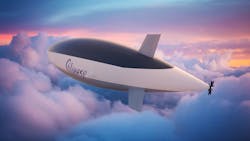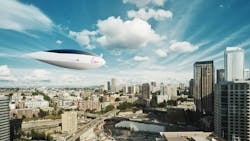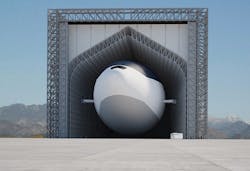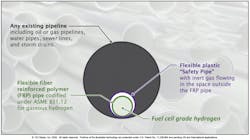READ MORE: The Case for the Hydrogen Economy
The Hydrogen Economy is gaining steam as companies and countries invest billions to produce energy from renewables and use it to extract hydrogen from water. The hydrogen is then put into fuel cells to generate electricity for cars and factories and to power combustion engines.
One weak link in this plan, however, is the reliance on pipelines and ships to transport the hydrogen from the solar panels and wind turbines to where it can be used or distributed to consumers and industry.
Fortunately, Rinaldo Brutoco, a strong proponent and pioneer of green hydrogen as the fuel of the future, has worked with the engineers at H2 Clipper, the company he founded and heads, to develop a pair of hydrogen transportation technologies that could make the Hydrogen Economy an economical and environmental boon.
The H2 Clipper Dirigible
The design team at H2 Clipper have designed a 1,000-ft long dirigible, called the H2 Clipper, that can carry 125 to 200 tons, letting it pick up liquid hydrogen at −423.4°F from places where it can be produced cheaply with renewable electricity—from the Middle East and the Sahara to offshore wind farms in the North Sea. Next, the hydrogen is cooled down into liquid and loaded into the airship that can carry it to storage and distribution hubs in consumer markets. The airship must carry liquid hydrogen because gaseous hydrogen is not sufficiently energy-dense to be transported cost-effectively over long distances. And in addition to carrying hydrogen, it will also use the lighter-than-air gas to provide lift to the giant transport airship.
“And even though hydrogen is flammable, our design uses proper safety technologies so that the hydrogen providing lift for the H2 Clipper will not explode even in the most severe of circumstances,” says Brutoco.
READ MORE: Innovative Airships Could Change the Face of Transport Aircraft
The H2 Clipper gets its thrust from four side-mounted, six-bladed propellers and an eight-bladed stern propeller. Each is powered by an electric motor with electricity coming from PEM fuel cells consuming gaseous hydrogen, solar cells mounted atop the airship, or diesel-powered generators burning biofuels. The motors put out a total of 33,200 shp.
The airship has a range of 6,000 miles and a top speed of 175 mph, thanks in part to the aircraft’s pointed nose and aerodynamic shape. The shape and strength of the airframe comes courtesy of its patented triangular-patterned exoskeleton that stretches from the nose to the tail. The exoskeleton eliminates the need for a forest of internal supports, thus opening the interior for more cargo-carrying flexibility.
A stiff outer shell covers the exoskeleton which improves the airship’s aerodynamics by cutting drag, thus making the Clipper faster through the air. The exoskeleton also supports the electric motors turning the props.
Like all aircraft, airships are vulnerable in bad weather. But Brutoco points out that the Clipper’s higher speed makes it safer than dirigibles of the past in that it lets the airship avoid thunderstorms and bad weather. Plus, the improved accuracy and availability of weather forecasts compared to what was available in the 1930s makes it safer for airships like the Clipper. Meteorologists using satellites data can make accurate five-day forecasts, giving airships pilots plenty of time to adjust their course.
Speed is important when the cargo is liquid hydrogen. No matter how good the insulation in the container holding the liquid hydrogen, some hydrogen will boil off. In a tanker ship traveling 15 knots for a week to get to its destination, that wasted hydrogen can add up. The Clipper, traveling much faster, loses less hydrogen, and the hydrogen that does boil off is recovered can be fed into the fuel cells powering the props.
Another downside of ocean-going tankers is that once they offload the hydrogen, they must travel empty to another destination to pick up more hydrogen, a money-losing voyage. The airship, on the other hand, with a cargo area of 265,000 ft3 and payload capacity of 340,000 lb, can be loaded with cargo containers to take goods and cargo directly to a factory or distribution site, making money on both legs of the trip. Carrying cargo on both legs thus lowers the cost of hydrogen delivery and offers fast factory-to-consumer distribution.
With an average cruising speed of 175 mph, the H2 Clipper should operate at a cost of between $0.177 to $0.247 per ton-mile for distances of 1,000 to 6,000 miles. This makes the Clipper less expensive than rail, trucks, ships and even pipelines for moving cargo distances of 1,000 miles or more. And it is way less expensive than using airplanes.
“Freight via airships will be up to 70% cheaper than cargo by plane, says Brutoco. “Even a transatlantic journey will take the Clipper less than a day. At top speed, the airship will only need twice the time of a regular aircraft.”
To demonstrate the Clipper’s advantage, consider a tanker taking 90 tons of liquid hydrogen from Australia to Japan. The 4,000-mile voyage would take a week and only two Japanese ports will be able to handle the new hydrogen tankers. A Clipper airship can take 160 tons of hydrogen to Japan in one day and deliver it anywhere in Japan; airships can take off and land from almost anywhere and only minimal infrastructure will be needed to load and unload cargo. Replacing tankers with green airships should help the environment. It is estimated that one diesel-powered tanker pollutes as much as 50 million cars.
Engineers at H2 Clipper have been working to reduce and simplify the needed ground infrastructure needed to load and unload liquid hydrogen and other cargo. They have already developed simplified docking and load/unload procedures which can be carried out using a single mooring mast with the Clipper free to pivot around it. It will take special equipment to work with liquid hydrogen and meet the load/unload times needed for commercial operations. Details about this are part of several patent applications and H2 Clipper considers them proprietary.
The Clipper only requires a relatively small crew, but H2 is designing the airship to be pilotless and autonomous, which will definitely make it the world’s largest drone.
“We initially plan for the H2 Clipper to have pilots onboard, but we’ve contemplated both modes of operation in our engineering and financial assumptions,” says Brutoco. “Using experience pilots to fly the airship and collect valuable operating data is part of our ‘continuous improvement’ engineering approach. Over time, we anticipate the vehicle will move towards fully autonomous operations, with a few ground-based operators overseeing several airships from a command and control center.”
H2 has patents covering autonomous flight operations; the optional use of artificial intelligence and remote real-time displays to assist in some maneuvers; improved means for docking in high winds; and using aerial drones to pick up, transport and delivering package goods. The firm also has patents on several pilot safety subsystems.
Pipe-Within-a-Pipe
Brutoco also has an ingenious plan for getting liquid hydrogen from storage depots to gas stations and factories: H2 Clipper’s patented “Pipe-within-a-Pipe” technology (PiP). The patented covers the overall system, method, and apparatus for safely and efficiently moving hydrogen up to 1,000 miles inside virtually any oil and gas pipeline, water pipe, sewer line, storm drain or other pipeline. Using existing inside pipelines that run below ground under nearly every major city and across many countries avoids the lengthy and costly challenge of building new pipelines. PiP will give the Hydrogen Economy a leg up in terms of distribution infrastructure. It also provides the safest and most cost-effective, readily deployable, and scalable way to deliver fuel cell grade hydrogen to end-users.
The PiP plan relies on flexible pipe rated for hydrogen use by the American Society of Mechanical Engineers (ASME B31.12). The pipe has a 50-year useful life at 2,500 psi. The pipe carrying hydrogen is placed inside a slightly larger diameter safety pipe. An inert gas, the “sweeper” gas, is sent between the two pipes to constantly remove any hydrogen that leaks from the inner pipe. This keeps the transported hydrogen’s purity at 99.7% or higher, pure enough to use in fuel cells for electric cars, buses, trucks and locomotives. It, along with sensors that monitor hydrogen levels in the safety pipe, also prevents hydrogen from collecting to the point it becomes a fire/explosion hazard.
“With the safety pipe, sweeper gas, and our proprietary continuous monitoring sensors in place, hydrogen can be run inside nearly any existing pipeline without interfering with the continued commercial use of that line,” says Brutoco. “It will save companies and governments hundreds of billions of dollars and avoid delays of years in getting the Hydrogen Economy up and running by eliminating the need to construct new hydrogen pipelines or retrofitting existing ones for hydrogen.
“Taken together, these measures will dramatically accelerate the hydrogen economy, which is our mission at H2 Clipper,” he adds.
H2 Clipper intends to work with existing pipeline companies, pipe manufacturers and large utility system integrators to deploy the technology as rapidly as possible.
H2 Clipper is building a prototype that it plans to flight test in 2025. The first operational airships should be delivered in 2027 and operational by 2029 if work now underway continues as planned and regulatory approval is relatively straightforward. Clipper airships are forecast to carry a $180 million sales price.



